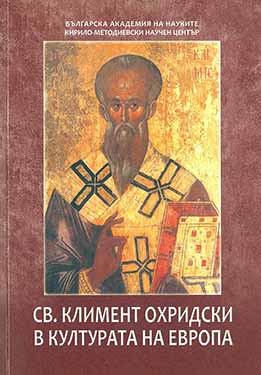Св. Климент Охридски, основател на образователната система в средновековна България
St. Clement of Ohrid, Founder of the Educational System in Medieval Bulgaria
Author(s): Tsvetana Cholova
Subject(s): Language studies, Language and Literature Studies
Published by: Кирило-Методиевски научен център при Българска академия на науките
Summary/Abstract: The Christian paideia was in the foundation of medieval education in Europe. It determined the philosophy, image and direction of the education as a continuation of the Hellenic-Roman educational and spiritual values transformed through the conception of Christianity for man as an “image and likeness of God“. The way to reach theosis of human as meaning of his life and salvation goes through his improvement by education and moral upliftment. The activities of the literary schools like Devol-Ohrid, Pliska-Preslav, Tarnovo, etc. had their own specifics. Though they followed the examples established in Byzantium and adopted by the Christian countries. Recently, archaeological discoveries and the gradual filling of the new archaeological map changed the basic concepts of the terms cultural site, centre or literary school. Each of them had its own place. Each of them also, had a different content. The terms, depending on the context, might be used separately; they were also interchangeable. As a whole, the terms reflected the specifics of the organization of cultural life in the Middle Ages. The educational functions of the literary schools have not yet been well studied. The attention of scientists is focused primarily on their literary purposes but their educational activities are not less important. Little is known for the specifics of their educational activities. The common belief that there are almost no secular works is far away from the truth. The dominance of religious content in textbooks is in synchrony with the era. The Disciples of St. Cyril and St. Methodius together with the introduction of a new alphabet and the translations of the holy writen and liturgical books into Old Bulgarian language, also transferred the organization of the educational system and teaching methodology of the Byzantium example. The educational system described in the Hagiography of St. Clement was adopted by the Byzantine (ancient) system of education, which was spread throughout the whole Roman Empire. Deeper understanding of the preserved information would show that the Bulgarian schools, established after the adoption of Christianity and the arrival of St. Cyril and Methodius disciples in Bulgaria, borrowed for the most part the model of organization of education of the Byzantine schools, but still had some specific elements. Education in Bulgarian schools recreated their common “external” organization – it was religious in form, in Old Bulgarian language and had Bulgarian character. The teaching of the next level in the literary schools in Bulgaria, that is called “encyclios paideia”, was adopted from Byzantium. The term meant education in general – the general education from primary to higher, including both philosophical education and education on various and social sciences – law, medicine, architecture, warfare, etc. The education was in Old Bulgarian language, which became the third classical language in medieval Europe along with Latin and Greek. The grammar, rhetoric, dialectic and philosophic education comprised the next educational course after the initial literacy. The theological education in Byzantium and Medieval Bulgaria had its own specifics. Unlike Western Europe where after the establishment of universities theological faculties were opened, there is no evidence of such faculties of the higher public schools in Byzantium. The secular nature of education was preserved there. The theology was taught mainly in monasteries where a famous cleric taught a small number of students or an individual. This system of education was transferred to Medieval Bulgaria where the general education was much more Christianized than in Byzantium in terms of its content and purpose. There is information that after the arrival of Sts. Cyril and Methodius’ disciples in Bulgaria the latter gathered the most prominent and worthy pupils. The teachers introduced them not only to the higher mysteries of theology, but above all they taught them in both life behavior and moral purity. The Hagiography of St. Clement of Ohrid mentions that he taught 3500 students; 300 of them were selected to learn theology. Very often the sources spoke about individual training in monasteries in which a young novice, who was trained for a monk, was attached to an older monk (an “old man”). The lad had to be taught above all in patience, humility and charity, and also, in Christian dogma and books. The literary models and genres created in Medieval Bulgaria are typological models for the Orthodox countries. The educational model and literature of the Bulgarian Middle Ages transferred and further developed in the European East. They became a foundation for spreading Christianity, theology, ancient philosophy, science and culture. Literary works and educational work of St. Clement of Ohrid serve as a model not only in Bulgaria in the following centuries, but also in other countries of the Orthodox Slavic world.
Book: Свети Климент Охридски в културата на Европа
- Page Range: 474-489
- Page Count: 16
- Publication Year: 2018
- Language: Bulgarian
- Content File-PDF

